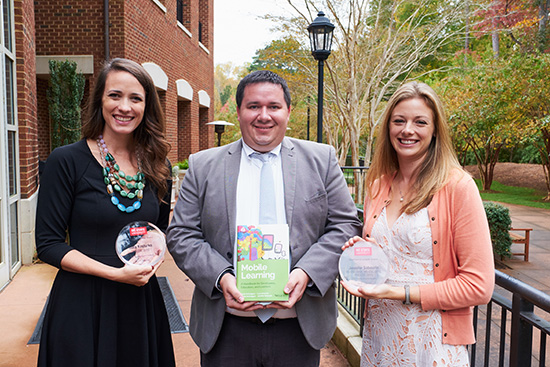CSC News
NC State Graduates Find Technical Solutions to Teacher’s Problems with Curriculum Pathways
 A computer science career encompasses many different fields.
From math to English to Spanish, computer science provides a future of
limitless opportunities.
A computer science career encompasses many different fields.
From math to English to Spanish, computer science provides a future of
limitless opportunities.
NC State computer science graduates Lucy Kosturko (MS ‘10), Scott McQuiggan (MS ’05, PhD ‘09) and Jennifer Sabourin (BS ’08, MS ’12, PhD ‘13) embody this every day in their careers at SAS. They serve on the Curriculum Pathways team directed by McQuiggan where Kosturko is a Curriculum Development Manager and Sabourin is a Research Scientist and Sr. Software Developer.
Their shared passion for computer science and education has helped grow a collaborative, interdisciplinary program benefitting students and teachers across the globe.
Curriculum Pathways from SAS is a platform that uses technology to enhance learning. To do this, Curriculum Pathways develops free resources to find technical solutions for common problems teachers face in the classroom. It offers more than 2,000 resources for students in grades K-12, and spans five core subjects of English, Math, Science, Social Studies and Spanish.
The program plays an important role in SAS’s philanthropic mission to create brighter futures for younger generations. McQuiggan points to Curriculum Pathways as being a major cornerstone of that commitment.
“At Curriculum Pathways, we’re fortunate to live out the company’s passion in education every day,” says McQuiggan. “There is no better place than SAS to have the freedom to solve the problems of teachers and students. That’s one of the things that makes SAS a great place to work.”
Kosturko, Sabourin and McQuiggan communicate with teachers about challenges and problems in their classroom, then collaborate with the Curriculum Pathways team to create solutions. The team's interdisciplinary approach goes beyond computer science to include psychology, art, social studies, math and other topics. The resulting resources, tools, and apps address many classroom needs, and include popular free resources such as CodeSnaps, Writing Reviser, and most recently, Crio.
“Coding is only a small part of computer science and software development. It really takes a village and it’s very collaborative,” says Kosturko. “Computer science has a reputation of being isolating when, in practice, it requires significant communication and teamwork.”
Sabourin credits her NC State education specifically for preparing her for such a rewarding and multi-faceted career.
“I really appreciated the flexibility to make my degree what I wanted by combining electives in areas such as psychology and education with courses within the department, on interesting topics like AI and machine learning, " says Sabourin. "I use what I learned in those different classes daily. It really prepared me for such an interdisciplinary career."
Dr. James Lester’s lab at NC State is a place that all three fondly remember as being an open environment that promoted cross-disciplinary collaboration among students.
“Dr. Lester’s lab is where we learned to work together - building on each other's creativity and critical thinking to spur innovation. It's the spirit of teamwork we apply every day at Curriculum Pathways," says McQuiggan. "We see this type of collaboration replicated across the other divisions at SAS, too. It is an effective approach to solving problems."
The three wrote a book in 2015 entitled Mobile Learning: A Handbook for Developers, Educators, and Learners. The book presents a comprehensive look at mobile learning by synthesizing relevant theories and drawing practical conclusions for developers, educators, and students. With the launch of the iPad and Curriculum Pathways first mobile app, Flash Cards, in 2010, the landscape of technology in the classroom was forever changed. With new technologies come new challenges discussed in the book.
“The book unites different perspectives of those who build, deploy, and use educational technology to ensure everyone is working with a common understanding," says Sabourin.
Kosturko, Sabourin, McQuiggan and the entire Curriculum Pathways team combine their shared passions and unique educational backgrounds to create free, high-quality resources used by more than 4.5 million teachers and students.
“A mentor of mine once shared that the best measure of success is getting to work with the people that you want to work with," says McQuiggan. “I take great pride in sharing this meaningful mission with SAS and the Curriculum Pathways team."
~scanlon~
Return To News Homepage